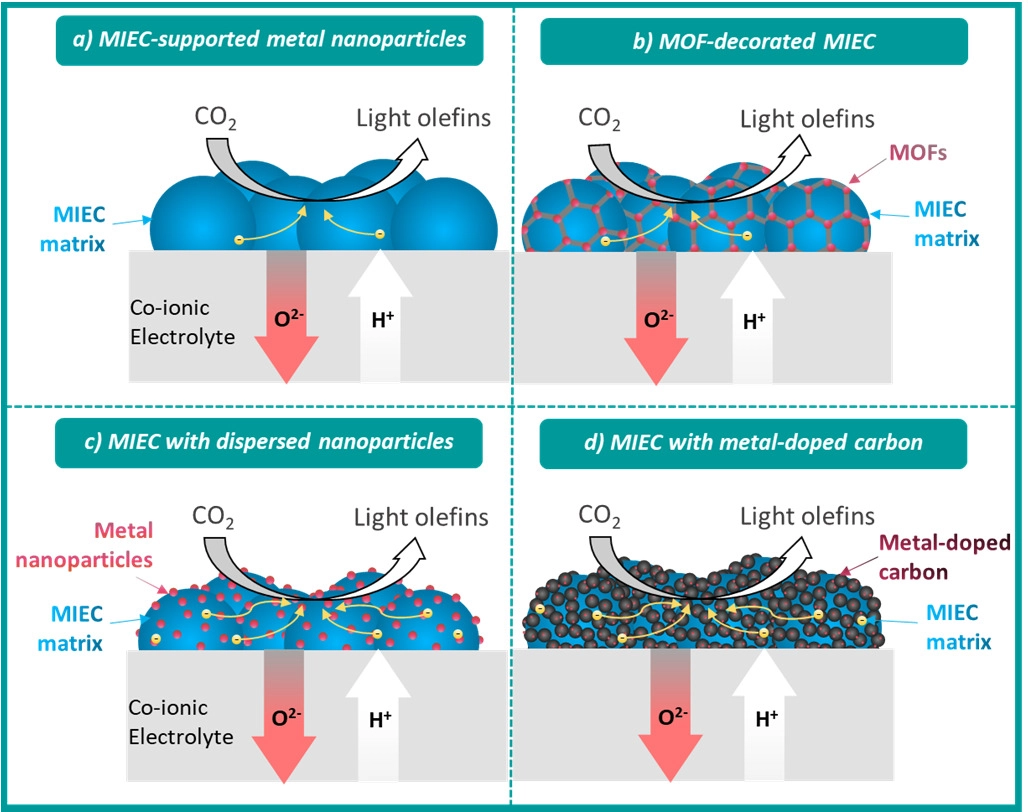- ecolefins@certh.gr
- 6th km Charilaou-Thermi Rd, Thessaloniki, Greece


About ECOLEFINS
CO-Ionics for carbon negative Petrochemicals
ECOLEFINS concept reverses the heavy CO2 emissions associated to the petroleum-based light olefins production to massive CO2 capture and valorisation for carbon negative ethylene, propylene and butylene. The project will introduce co-ionic ceramic membrane reactors and short-stacks/modules that merge the anodic steam electrolysis for hydrogen production with the cathodic CO2 electrolysis and hydrogenation to light olefins, over tailored and nano-engineered electrodes; aiming to develop a substantially more effective technology, for the single-step, RES-powered artificial photosynthesis of CO2 to valuable chemicals.
The ambition of ECOLEFINS entails a multi-disciplinary task, requiring highly tuned synergies among cutting edge research in the fields of:
- Advanced materials science & engineering for co-ionic composites, perovskite ex-solutions, and organometallics
- Electrochemistry and electrochemical process engineering
- Catalysis science and engineering
- Computer aided materials design and atomic scale modelling
- Digital real-scale process modelling and economic evaluation, along with a comprehensive sustainability assessment, applied social research for impact framing, and marketization planning
Our Services
Breakthroughs
The proposed, integrated CO2 hydrogenation and H2O electrolysis ECOLEFINS approach includes the following breakthroughs:
Dual-phase ceramic electrolytes aided by DFT calculations
The development of dual-phase ceramic electrolytes aided by DFT calculations with co-ionic conductivity of both protons (H+) and oxide anions (O2-), at moderate temperatures (300 – 400 oC)
Metal-Organic Frameworks (MOFs) and Covalent-Organic Frameworks (COFs)
The incorporation of Metal-Organic Frameworks (MOFs) and Covalent-Organic Frameworks (COFs) into the MIEC cathode matrices, as multi-purpose agents.
Exsolution
The utilization of exsolution in perovskites to develop cathodes/anodes consisting of functional mixed electron/ion conducting (MIEC) oxide matrices decorated with uniformly dispersed nanoparticles of exceptional catalytic performance.
For the simultaneous H+ supply and O2- withdrawal from the cathodic electro-catalyst and to in-situ tune its surface chemistry for C2-4= selective electro-synthesis
Vision
The vision of ECOLEFINS includes:

01
The synthesis of light olefins from H2O and CO2 co-electrolysis by combining the exothermic C2-4= synthesis with the endothermic steam electrolysis in a single electrochemical membrane reactor at atmospheric pressure achieving +15% energy efficiency

03
The scale up of the concept to short planar stacks and tubular modules

02
The drastic increase of CO2 conversion and C2-4= selectivity by controlling the H+ supply and suppressing CO and CH4 formation


Long term impact
ECOLEFINS aspires to the following long-term impacts:
The CO2-to-olefins tailored innovations for cathodic electrocatalysts and co-ionic membranes of controlled H+/O2- supply/withdrawal intends to considerably improve C2-4 =yield, compared to the SoA thermocatalysis. Besides, the mid-temperature electrolysis, along with the elimination or the drastic reduction of the high- pressure requirement, promise significant efficiency gains. These combined, project a long-term vision of high impact and transformative effect within the core of the energy intensive commodity chemical industry. The envisioned technology is fully aligned to the EU Green Deal Strategy, to make Europe the first carbon-neutral continent and to transform EU’s chemical Industry into a global innovation hub. Based on zero-cost and abundant H2O/CO2 as well as the high production volumes of C2-4=, ECOLEFINS concept aspires to be a key “artificial photosynthesis” step for sustainable Power-to-Chemicals routes.
Contact Us
Request a Call Back
Please contact us for more information
Email Us Now
- ecolefins@certh.gr
Address
6th km Charilaou-Thermi Rd, Thessaloniki, Greece
Latest Blog
News & Updates
News
This research has received funding from the European Union under grant agreement No 101099717 – ECOLEFINS project and UK Research and Innovation (UKRI) under the UK governments Horizon Europe funding Guarantee (10079292). Views and opinions expressed are however those of the author(s) only and do not necessarily reflect those of the European Union or European Innovation Council and SMEs Executive Agency (EISMEA) or UK Research and Innovation granting authorities. Neither the European Union nor the granting authorities can be held responsible for them.












